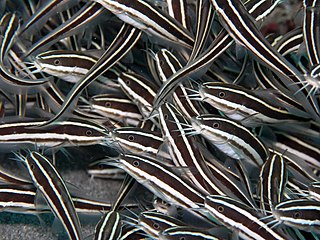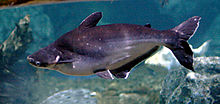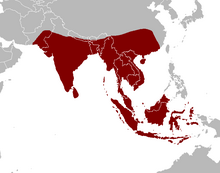
Catfish are a diverse group of ray-finned fish. Named for their prominent barbels, which resemble a cat's whiskers, catfish range in size and behavior from the three largest species alive, the Mekong giant catfish from Southeast Asia, the wels catfish of Eurasia, and the piraíba of South America, to detritivores, and even to a tiny parasitic species commonly called the candiru, Vandellia cirrhosa. Neither the armour-plated types nor the naked types have scales. Despite their name, not all catfish have prominent barbels or "whiskers". Members of the Siluriformes order are defined by features of the skull and swimbladder. Catfish are of considerable commercial importance; many of the larger species are farmed or fished for food. Many of the smaller species, particularly the genus Corydoras, are important in the aquarium hobby. Many catfish are nocturnal, but others are crepuscular or diurnal.

Callichthyidae is a family of catfishes, called armored catfishes due to the two rows of bony plates along the lengths of their bodies. It contains some of the most popular freshwater aquarium fish, such as many species in the genus Corydoras.

The eeltail catfish are a family (Plotosidae) of catfish whose tails are elongated in an eel-like fashion. These catfishes are native to the Indian Ocean and western Pacific from Japan to Australia and Fiji. The family includes about 41 species in 10 genera. About half of the species are freshwater, occurring in Australia and New Guinea.

Trichomycteridae is a family of catfishes commonly known as pencil catfishes or parasitic catfishes. This family includes the candiru fish, feared by some people for its alleged habit of entering into the urethra of humans. They are one of the few parasitic chordates. Another species is the life monsefuano which was important to the Moche culture and still an important part of Peruvian cuisine.

The Doradidae are a family of catfishes also known as thorny catfishes, raphael catfishes or talking catfishes. These fish are native to South America, primarily the Amazon basin and the Guianas.

Sisoridae is a family of catfishes. These Asian catfishes live in fast-moving waters and often have adaptations that allow them to adhere to objects in their habitats. The family includes about 235 species.
Pimelodina flavipinnis is the only species of the genus Pimelodina of the family Pimelodidae of catfish.
Aguarunichthys is a genus of long-whiskered catfishes native to South America.

Bagarius is an Asian genus of catfishes of the family Sisoridae. It includes five to six extant species and potentially one extinct fossil species, B. gigas.

Cetopangasius chaetobranchus is an extinct species of catfish of the family Pangasiidae. This fish was from a Miocene lake fauna from what is now Ban Nong Pia, Phetchabun Province of Thailand.

Pangasius is a genus of medium-large to very large shark catfishes native to fresh water in South and Southeast Asia. The term "pangasius" is sometimes used to specifically refer to the commercially important basa fish, P. bocourti.
Typhlobelus is a genus of pencil catfishes native to South America.

The bayad, is a species of bagrid catfish from Africa.
The Somalia catfish is a species of catfish in the family Bagridae. The Somalia catfish is native to the Jubba River in Somalia.

Platystacus cotylephorus, the Banded banjo, is a species of banjo catfish. It is the only member of its genus. The genus Platystacus is the sister group to a clade containing Aspredo and Aspredinichthys. P. cotylephorus originates from coastal waters and lower portions of rivers of northern South America, from Venezuela to northern Brazil.
Aspredinichthys is a genus of banjo catfishes found in fresh and brackish waters in tropical South America from the Orinoco delta, through the Guianas, to the Amazon delta. Both species are found in lower portions of rivers and in coastal waters of northern South America from Venezuela to northern Brazil where they are benthic fish.

Galeichthys is a genus of sea catfishes in the family Ariidae, the only genus in the subfamily Galeichthyinae. It includes four predominantly marine species distributed in Southern Africa and northwestern South America:
Amissidens hainesi, the ridged catfish, is the only species of catfish in the genus Amissidens of the family Ariidae. This species occurs in marine and brackish waters on the southern coast of New Guinea and Northern Australia, between Darwin and southern Gulf of Carpentaria.

Arius is a genus of catfishes of the family Ariidae. The genus Arius is distributed in brackish and fresh waters of Eastern Africa and south to Southeast Asia.

Pangasius indicus is an extinct species of catfish of the family Pangasiidae. This fish was a member of the "Sipang Fauna", a lagerstatte from Sipang, Sumatra, of indeterminate age, possibly either Eocene, Oligocene, or even Miocene in age.















